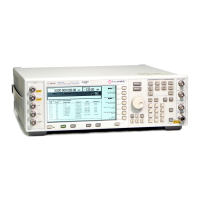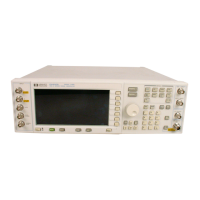106 Chapter 4
Basic Digital Operation
Using the Dual ARB Waveform Player
Using the Dual ARB Waveform Player
The dual arbitrary (ARB) waveform player is used to play back waveform files. There are two types of
waveform files: segments and sequences. A segment is a waveform file that is created using one of the
signal generator’s pre-defined ARB formats (Custom, W-CDMA, CDMA2000, etc.). A sequence can be
described as several segments strung together to create one waveform file. Waveform files can also be
created remotely using another signal generator or using computer programs and downloaded to the ESG for
playback by the dual ARB waveform player. For information on downloading waveforms, refer to the
E4428C/38C ESG Signal Generator Programming Guide. The dual ARB player is used to rename and store
waveform files and to load waveform files from the signal generator’s memory.
A waveform file is automatically generated whenever an ARB modulation format is turned on. This
automatically generated file is named AUTOGEN_WAVEFORM. Because this default file name is shared among
all ARB formats, it must be renamed if you want to save the information contained in the file. If the file is
not renamed, it will be overwritten when another ARB format is turned on.
Before you can play or edit any waveform file, it must reside in volatile waveform memory. The signal
generator has two types of memory, WFM1 (volatile waveform memory) and NVWFM (non-volatile
waveform memory). Load a stored waveform file from NVWFM into volatile memory (WFM1) where it
can be edited or played by the ARB waveform player.
The dual ARB waveform player provides markers (page 129), triggering (page 145), and clipping (page
154) capabilities.
Accessing the Dual ARB Player
Press Mode > Dual ARB.
The first-level softkey menu is shown in the following figure. Most procedures start from this menu.

